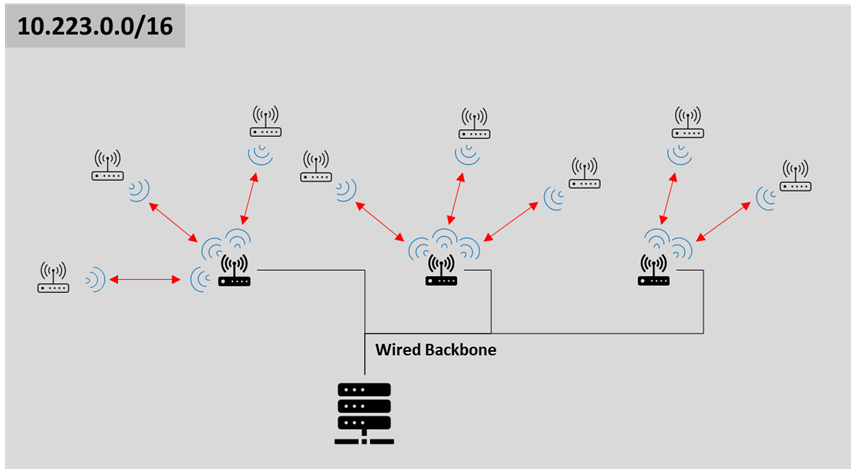Supported Networking Modes
Default Network Configuration
The Mesh Rider Radio runs Doodle Labs Mesh Rider® OS, a customized version of Openwrt with enhancements. These enhancements are useful for applications requiring low-latency command-and-control transmission, HD Video, high-throughput, and long range. Fig. 1 shows the default network configuration of Mesh Rider Radio.

Fig. 1 Default Network Configuration
Mesh Rider Radio Network Topologies
The Mesh Rider Radio supports several different network configurations. The Simple Config menu makes it easy to configure the radio. The Simple Config menu is accessed in the web GUI at network -> simple config.
Basic Network Configurations
The Simple Configuration menu is shown in Fig. 2 (UAV Profile). It should be the starting point of any network design. To begin, choose either the General, UAV, or GCS profile (more profiles will be added in future). The configuration boxes will be filled with recommended settings. From here, you should first choose the mode which you want to switch to, and a selection of the more common configuration options, and then click Apply.
The Simple Configuration menu is split into several sections: serial port, central configuration, wireless, network, and traffic prioritization.
- The serial port is only shown in the UAV profile, and by default the GCS finder utility is enabled. Both the serial port and GCS finder utility can be accessed from the Services menu if you want to change them later.
- For central configuration, there should be only one primary node. All other nodes should fill in the primary node's IP address.
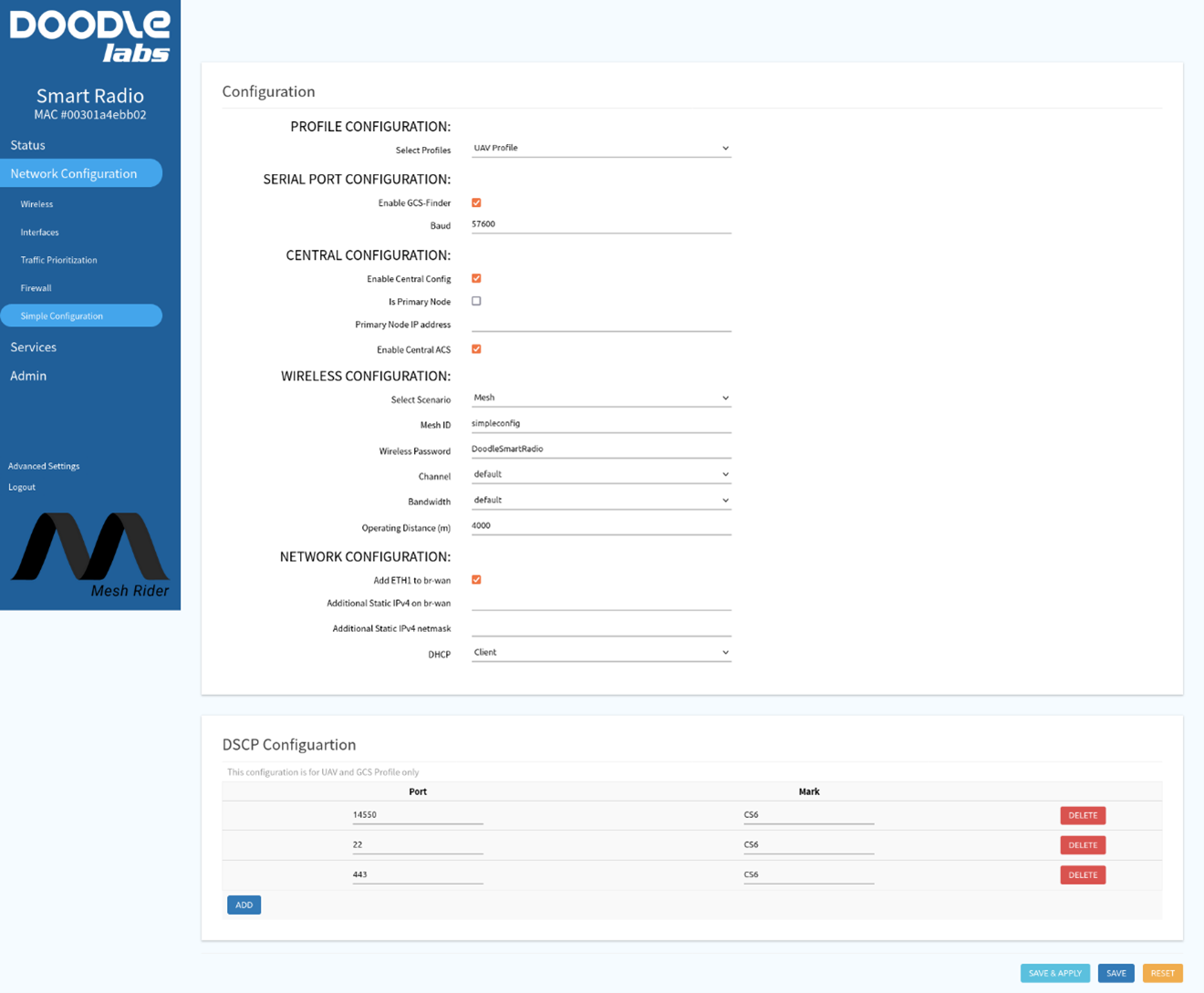
Fig. 2 Simple Configuration Menu
These are the supported network configurations.
- Mesh
- WDS AP/Client
- Dynamic Mesh
The basic network configuration in any of these modes is designed so that the entire Mesh Rider Radio network acts like one big Ethernet switch. Any host machines plugged into this "Ethernet switch" will be able to communicate with one another if they are on the same IP subnet, regardless of the IP addresses of the Mesh Rider Radios. To access the Mesh Rider Radios themselves, however, it is necessary for the host machines to be on the same IP subnet as the Mesh Rider Radios.
Mesh
All Mesh Rider Radios are set up in Mesh mode by default. In mesh mode, all nodes are able to communicate directly with each other and data can even hop between nodes to reach a destination. This is illustrated in Fig. 3. Maintaining the mesh requires additional network overhead compared to WDS AP/Client mode. Some benefits of Mesh mode compared to other modes include
- The network is homogenous and there is no need to configure each node differently
- There is no single point of failure
- The network can be extended beyond the line of sight through intelligent packet routing

Fig. 3 Mesh mode
WDS AP/Client
WDS AP/Client mode is a star network configuration. All data must go through the AP. If meshing is not required, this is the preferred network mode as it is more responsive than Mesh mode.
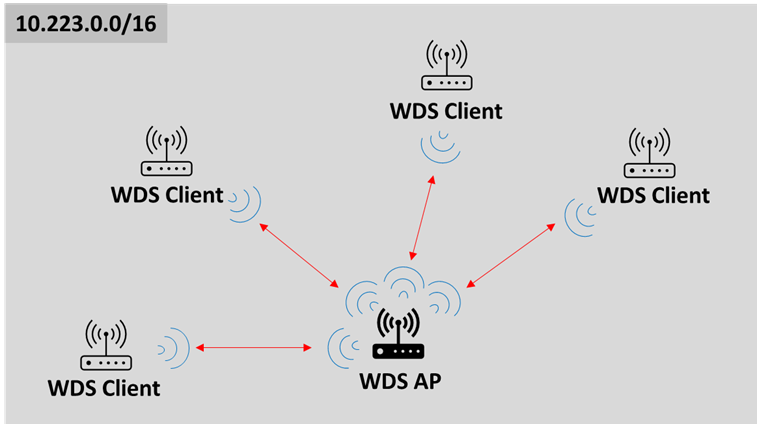
Fig. 4 WDS AP/Client mode
Some benefits of WDS AP/Client mode compared to the others
- It provides the highest throughput
- It automatically searches for the best channel on start-up
- Client devices automatically scan and reconnect to the AP if the AP switches channels
Dynamic Mesh
Dynamic Mesh is a state-of-the-art network protocol based on establishing multiple redundant paths in a mesh network. Dynamic Mesh has ZERO packet re-routing or failover time. Dynamic Mesh also supports dual radio failover where two back-to-back radios on the same or different frequency bands route packets redundantly between nodes (Fig. 5). This makes Dynamic Mesh best-in-class in terms of latency and resiliency in highly dynamically changing environments.
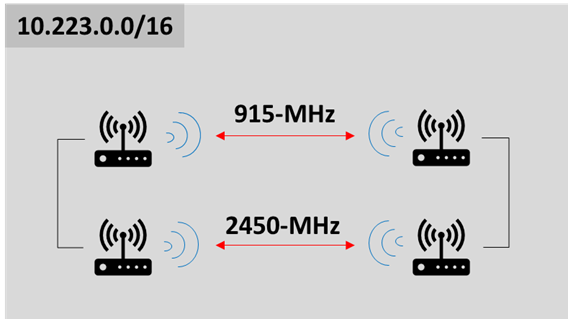
Fig. 5 Dual Radio Dynamic Mesh
Some benefits of Dynamic Mesh mode compared to other modes include
- ZERO failover or packet re-routing time
- No single point of failure
- Can support very large number of nodes in a single network
Extended Modes
Aside from the basic network configurations above, the Mesh Rider Radio also supports
- Gateway mode
- Multi-Radio Mesh mode
- Mesh + AP mode
- Wired Backbone
Gateway Mode
Gateway mode is supported in both WDS AP/Client and Mesh modes. In Gateway mode, one node is elected as a gateway to a wider network (the internet for example). The main data interface is connected to your modem, and performs NAT between the Mesh Rider Radio's LAN and the wider network. Additionally, the gateway Mesh Rider Radio starts a DHCP server on the LAN on the 10.222.0.0/16 subnet and a gateway IP address of 10.222.1.1. From firmware version 2022-02 onwards, ETH1 runs the DHCP client which connects to your modem, and ETH0 is bridged to the local network. Fig. 6 illustrates gateway mode for a mesh configuration.
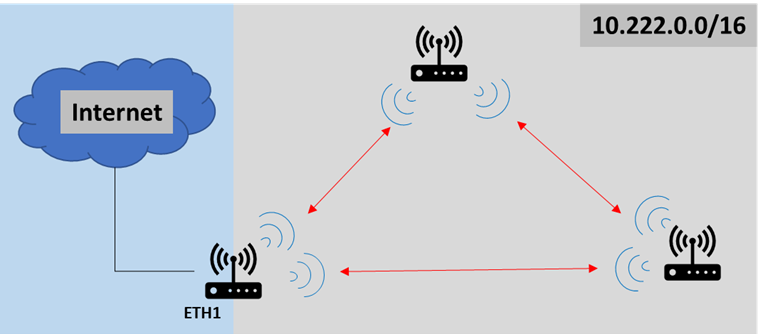
Fig. 6 Gateway mode
Multi-Radio Mesh mode
Multi-Radio Mesh mode is specifically designed to extend the range of a network without sacrificing throughput. Looking at the diagram below, if both sets of radios operated in the same band, then they would need to share airtime. In Multi-Radio Mesh mode, radios are connected to each other over wire using the ETH1 interface.

Fig. 7 Multi-Radio Mesh
Mesh + AP mode
Mesh + AP mode is illustrated in Fig. 8. Two or mode units form a mesh backbone and also run an AP which is bridged to the mesh. Of note is that this is standard AP mode and not WDS AP mode. The APs are interoperable with standard WiFi clients for 2.4-GHz models if the channel bandwidth is set to 20-MHz.

Fig. 8 Mesh + AP mode
Wired Backbone
Although not a selectable mode, the Mesh Rider Radio supports extension of the network with a wired backbone in all three basic modes. In Mesh mode, it is necessary to enable "Bridge Loop Avoidance" when using a wired backbone. In WDS AP/Mode, no additional configuration is required, and clients can roam between WDS APs even with the APs on different operating channels. The typical handover duration is 0.2 seconds for APs in the same channel and 0.6 seconds for APs in different channels. Dynamic Mesh also supports use of a wired backbone with zero failover time.
